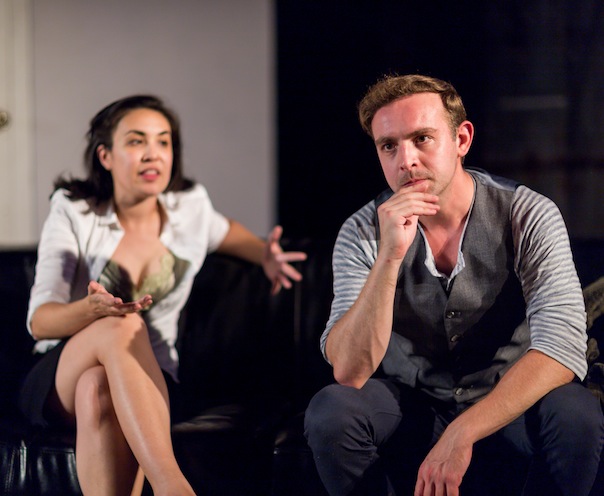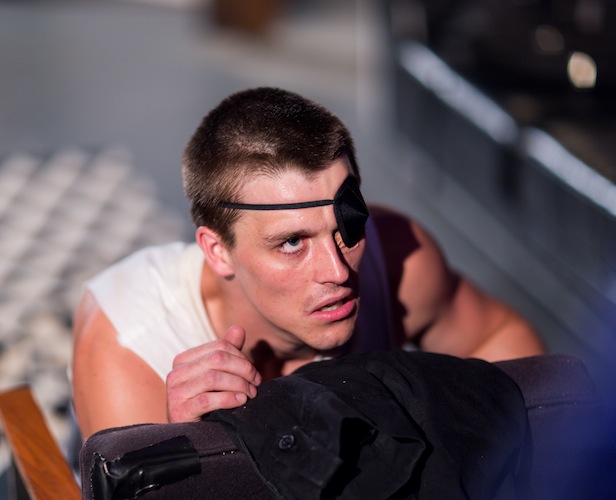Theater Review: “Eyes Shut. Door Open.” – Cain and Abel South of Houston Street
The script’s suggestion of mythological violence elevates Eyes Shut. Door Open. above the formulaic “dark domestic secrets revealed at a family reunion” plot line.
Eyes Shut. Door Open. by Cassie M. Seinuk. Directed by Christopher Randolph. Presented by Wax Wings Productions at The Inner Sanctum, Dudley Square, Roxbury, MA. Through August 15.

Melissa M. DeJesus and Victor Shopov in the Wax Wings Productions of “Eyes Shut. Door Open.” Photo: Nile Hawver/Nile Scott Shots.
By Ian Thal
Turner Street (Victor Shopov) stands to the side at the opening reception for his latest gallery show. Surveying the room, a mostly full champagne flute in one hand, he basks in his rise to fame on the SoHo art scene, even as he spews contempt for the hollow consumerism that has elevated his paintings to status symbols amongst the monied elite. His audience is Johanna (Melissa M. DeJesus), a server working for the event’s caterer.
Johanna is a curiosity in Turner’s eyes. Unlike the superficial socialites and heiresses he typically beds, she is unimpressed with his fame and the public persona Street adopts to sell himself to collectors. (It is also a mask he uses to keep frequent PTSD flashbacks to his childhood at bay.) She also correctly interprets the symbolism underlying his abstract works (“they’re all paintings of eyes,” she observes). He entices her to his home by offering to show her work he claims is too “raw” for his dealer to sell to the usual clients. The motives behind the flirtation are ambiguous: even he isn’t sure if it is because he finds her intriguing or he is worried that she might demystify his mystique, ruining his market value. Once at his place, he becomes reluctant to show her the paintings he promised, keeping his studio door locked.
Dramatist Cassie M. Seinuk describes Eyes Shut. Door Open. as a modern Cain and Abel story, so it isn’t long before the potential one-night-stand is interrupted by the surprise arrival (via a bus ride from Ohio) of Turner’s much younger brother, Palmer Street (Michael James Underhill). Palmer is a twitchy, eye-patch wearing, pill-popping drug addict whose existence Turner rather not acknowledge and whose presence he does not welcome. It doesn’t take the audience or Johanna long to see the link between Palmer’s injury and Turner’s paintings.
Seinuk, of course, knows her mythology, and the allusion to and repetition of mythological violence elevates Eyes Shut. Door Open. above the popular plot formula of dark domestic secrets revealed at a family reunion. The Street boys are from Eden, a small township in the mostly rural Seneca County in northern Ohio. The father, who appears to Turner via flashbacks, inexplicably favored the younger son over the older (just like the God in Genesis 4). Turner’s apartment prominently features a bowl of apples.
Without revealing spoilers it is soon obvious that Johanna is neither a passive witness nor or a trophy in the fraternal conflict between Turner and Palmer. Her name alone makes her role clear: Johanna is derived from the Hebrew Yohannah, a feminine variant of the masculine name Yehohanan — which, containing the tetragrammaton YHWH as a root, translates as “God is gracious.” (Not surprisingly, she attempts to soften Turner’s heart towards his brother, albeit for her own ulterior motives.) Johanna is a writer, and some traditions of Jewish mysticism hold that God is the author of the Torah. (The names of the Street boys are also meaningful, but as tie-ins to their on-stage actions.)
Seinuk does not just draw on Hebraic mythos for her symbolism. The Norse deity Odin plucked out one of his eyes for the gift of wisdom. In Greek mythology, Oedipus pierced his eyes upon learning a truth; Tiresias, the seer, was blinded by Athena, the goddess of strategy; and Polyphemus, the inhospitable cyclops, was blinded by Odysseus and his Achaeans warriors. All these violent and bloody myths resonate in this narrative.
The cast is well matched for one another and the complexity of the characters. Shopov maintains a swaggering facade as Turner, hinting at the nihilism, self-loathing, and inauthenticity that squats within. Underhill evokes the twitchy impulsivity of an addict, while also pouring on the kind of lost-puppy charm that can make wounded (but untrustworthy) souls so charismatic. DeJesus, as Johanna, projects a cagey intelligence, in particular her technically controlled use of her eyebrows, flickers worthy of Indian classical dance or the legendary Greek actress Irene Papas. Her fingers are also marvelously expressive — watch them reflect her increasing nervousness as her plans begin to go awry.
Rose Fieschko’s fight choreography is particularly well-orchestrated. Because of the decade that separates Turner and Palmer in age, it is clear that — unlike many brothers — they never had a real physical fight during childhood. The violence that erupts here is most likely the first time they have battled. As they grapple, there are pauses, each strategizing on how to gain the upper-hand, moments of exhaustion where the combatants attempt to catch their breath and regain their balance. There are even occasions when audience members might become briefly anxious that the actors have gone too far and worry that there’s been a genuine injury. The intimate performance space of the Inner Sanctum encourages this kind of visceral engagement.

Michael James Underhill in the Wax Wings Productions of “Eyes Shut. Door Open.” Photo: Nile Hawver/Nile Scott Shots.
Unfortunately, while the top-notch performances brought out the dramatic potency of the script, many of the production design elements were uneven, and at times undermined the actors’ efforts. The unevenness is inexplicable given that a number of the designers in this production collaborated with Seinuk earlier this year on her From The Deep (directed by Lindsay Eagle). One has to wonder why director Christopher Randolph, clearly a firm helmsman when it comes to the performative elements of the play, didn’t connect strongly enough with the designers.
Lighting designer Christopher Bocchiaro (whose work I generally admire — particularly in ASP’s recent production of Measure for Measure, and Apollinaire’s Blood Wedding) and sound designer Patrick Greene made some messy missteps here. Turner’s PTSD flashbacks were conveyed through a number of unsubtle and clichéd choices: Red-lit chiaroscuro, voices slowed down, distorted, and pitch-shifted down an octave or more. The upshot was memories of trauma made campy rather than cathartic – the episodes were suited to a straight-to-cable horror movie. (That said, Greene’s mash-up of the Chordettes’ 1954 recording of Pat Ballard’s “Mr. Sandman” and found-sound collage made for a particularly good opener to the show; if only he had maintained that ironic sensibility throughout.)
While the exposed brick, steel girders, pipes and heavy wood beams of the former factory space of the Inner Sanctum (housed in the same building that was once home to the now defunct alternative art-space The Berwick Research Institute during the previous decade) was an excellent choice both for the art gallery and and Turner’s loft space, some of the set (Kyle Blanchette) and prop (Lauren Annese) design doesn’t ring true or serve the story. Turner’s bookcases seemed entirely too bare for an artist live-in/work space — the set looked more like a place where the monied socialites whom Turner despises would hang out. The use of blank canvases to represent Turner’s work — perhaps to suggest that he is an artist of transcendent talent — is perplexing. The dialogue strongly suggests that he may very well be a one-trick-pony approaching his tenth or twelfth minute of fame. Seinuk’s stage directions in the script are slightly ambivalent about whether these canvases should be blank or picture “obscured eyes.” What is clear is that weak production elements are obscuring a powerful performance of an intensely relentless script.
Ian Thal is a playwright, performer and theater educator specializing in mime, commedia dell’arte, and puppetry, and has been known to act on Boston area stages from time to time, sometimes with Teatro delle Maschere. His one-act play The Second Annual Administration Building Takeover and the Slumber Party premieres at Boxfest Detroit later this summer. He has performed his one-man show, Arlecchino Am Ravenous, in numerous venues in Massachusetts and Rhode Island. One of his as-of-yet unproduced full-length plays was picketed by a Hamas supporter during a staged reading. He is looking for a home for his latest play, The Conversos of Venice, which is a thematic deconstruction of Shakespeare’s The Merchant of Venice. Formerly the community editor at The Jewish Advocate, he blogs irregularly at the unimaginatively entitled From The Journals of Ian Thal, and writes the “Nothing But Trouble” column for The Clyde Fitch Report.
